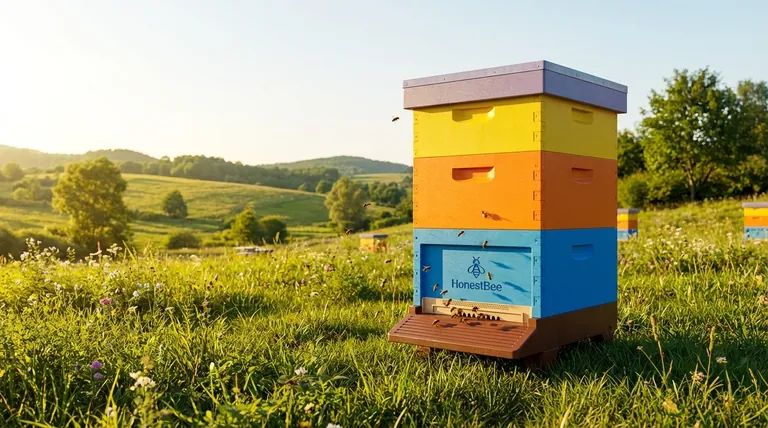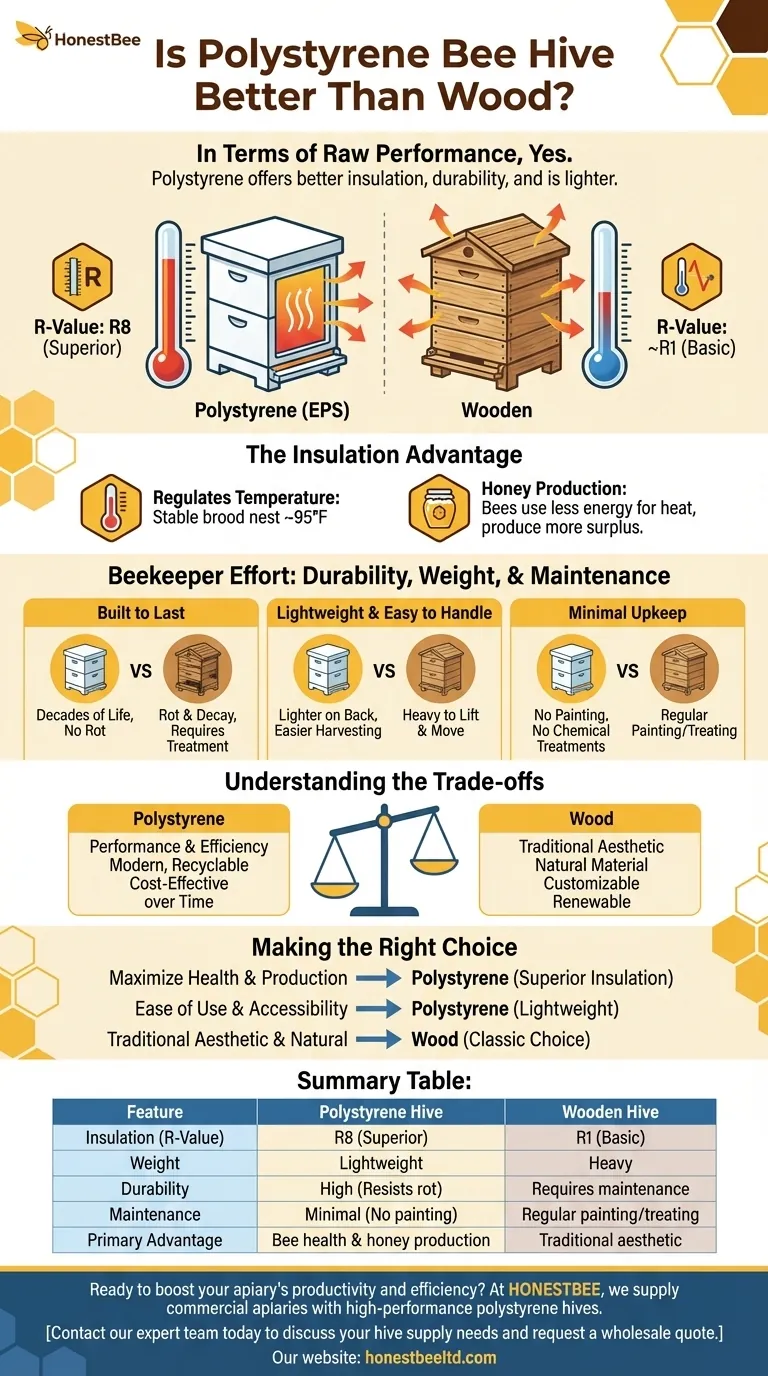In terms of raw performance, yes. Polystyrene hives offer significantly better insulation, durability, and are lighter than traditional wooden hives. This superior thermal regulation can lead to healthier bee colonies and increased honey production, making them a functionally superior choice for many beekeepers.
The decision between polystyrene and wood is a fundamental trade-off. You are choosing between the superior insulation, lower maintenance, and lighter weight of modern polystyrene hives and the traditional aesthetic and natural appeal of classic wooden hives.

The Insulation Advantage: A Core Performance Metric
The most significant difference between the two materials is their ability to regulate temperature. This factor has a direct impact on the health and productivity of your colony.
Regulating Hive Temperature
Bees must work constantly to maintain the brood nest at a stable temperature (around 95°F or 35°C). Poor insulation forces the colony to expend more energy and consume more food stores just to stay warm in winter and cool in summer.
The R-Value Difference
High-density expanded polystyrene (EPS) offers a dramatic improvement in insulation. It has an R-value of around R8, compared to the approximate R1 value of a standard wooden hive box.
This means polystyrene provides up to 8 times the insulating value, creating a much more stable internal environment for the bees.
Impact on Honey Production
A well-insulated hive allows bees to redirect their energy from temperature regulation to other tasks, like foraging and raising brood.
Because they consume less of their own honey stores to generate heat, colonies in polystyrene hives often produce a larger surplus of honey for the beekeeper to harvest.
Beekeeper Effort: Durability, Weight, and Maintenance
Beyond bee health, the choice of material directly affects the beekeeper's workload and long-term costs.
Built to Last
Polystyrene is a synthetic material that is not prone to rot, fungus, or termite damage. While a wooden hive will eventually begin to degrade from exposure to the elements, a polystyrene hive can last for decades with minimal wear.
Lightweight and Easy to Handle
Polystyrene hives are significantly lighter than their wooden counterparts. This makes lifting boxes for inspections, moving hives to new locations, and harvesting honey much easier on the beekeeper's back.
Minimal Upkeep
Wooden hives require regular maintenance, including painting or treating to protect them from moisture and decay. Polystyrene hives require no such chemical treatments or painting, saving both time and ongoing expense.
Understanding the Trade-offs
While polystyrene excels in performance, it is not without considerations. A balanced view is necessary to make the right choice.
The Case for Wood
Wooden hives have been the standard for centuries. They offer a natural, traditional aesthetic that many beekeepers prefer. Wood is a renewable resource and allows for more customization and repairs.
Potential Downsides of Polystyrene
While durable against weather, high-density polystyrene can be damaged by careless use of a sharp hive tool. It also lacks the classic look and feel that draws many people to beekeeping.
Long-Term Cost and Environmental Impact
Polystyrene may have a higher initial purchase price but often proves more cost-effective over its lifespan due to its durability and lack of maintenance costs. Furthermore, high-quality polystyrene used for hives is 100% recyclable.
Making the Right Choice for Your Goal
Your priorities as a beekeeper should guide your final decision.
- If your primary focus is maximizing bee health and honey production: Polystyrene is the clear choice due to its superior insulation.
- If your primary focus is ease of use and physical accessibility: The lightweight nature of polystyrene makes it the ideal option.
- If your primary focus is a traditional aesthetic and the use of natural materials: A well-maintained wooden hive remains the classic and correct choice for you.
Ultimately, selecting the right hive material is about aligning your equipment with your personal beekeeping philosophy and objectives.
Summary Table:
| Feature | Polystyrene Hive | Wooden Hive |
|---|---|---|
| Insulation (R-Value) | R8 (Superior) | R1 (Basic) |
| Weight | Lightweight | Heavy |
| Durability | High (Resists rot, decay) | Requires maintenance |
| Maintenance | Minimal (No painting) | Regular painting/treating |
| Primary Advantage | Bee health & honey production | Traditional aesthetic |
Ready to boost your apiary's productivity and efficiency?
At HONESTBEE, we supply commercial apiaries and beekeeping equipment distributors with high-performance, durable polystyrene hives designed for superior results. Our wholesale-focused operations ensure you get the best equipment to support healthier colonies and maximize honey production.
Contact our expert team today to discuss your hive supply needs and request a wholesale quote.
Visual Guide

Related Products
- Professional Insulated Plastic Bee Hives
- Professional Insulated Winter Hive Wrap for Beekeeping
- HONESTBEE Advanced Ergonomic Stainless Steel Hive Tool for Beekeeping
- HONESTBEE Professional Long Handled Hive Tool with Precision Cutting Blade
- Honey Flow Garden Bee Hive Flow Hive Best Beehive for Beginners
People Also Ask
- How much additional time does having more hives require? Master Efficient Apiary Management
- What color should beehives be painted? The Best Choice for Hive Health and Honey Production
- How does the longevity of plastic bee hives compare to wooden hives? Discover the Durable Choice
- How does the orientation of the hive sides benefit comb construction? Ensure Straight, Movable Combs for Easier Hive Management
- What is the purpose of a bee box? A Complete Guide to Modern Hive Management



















